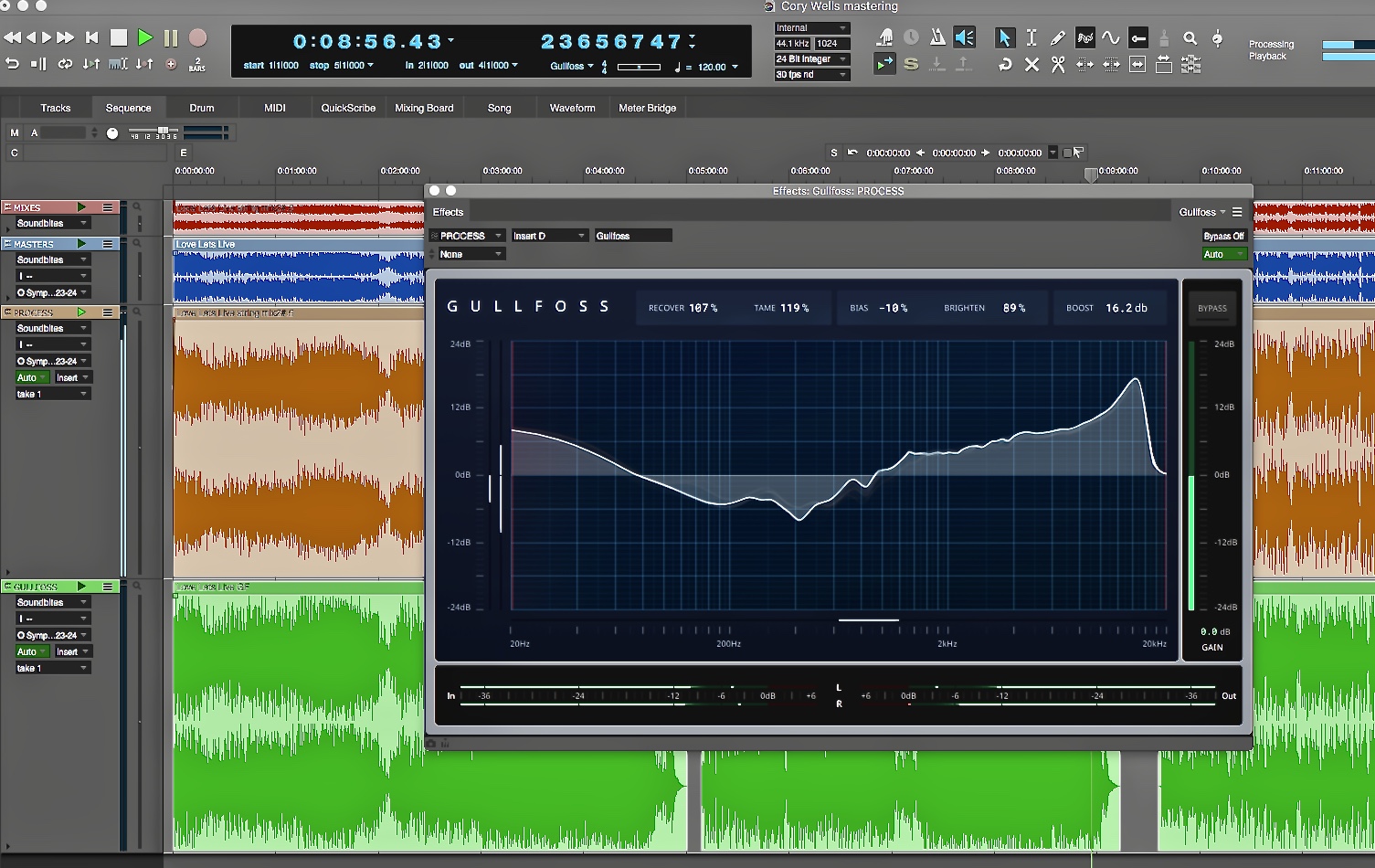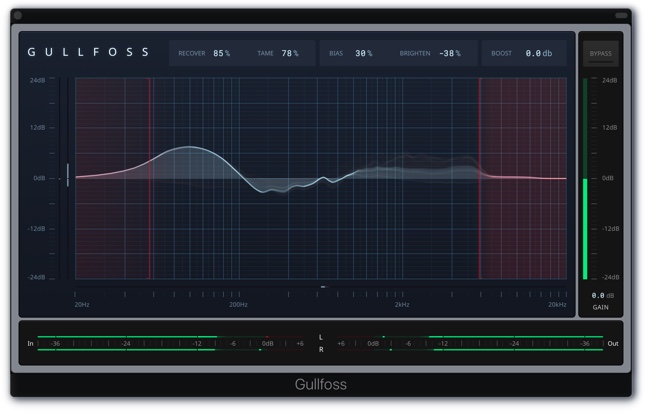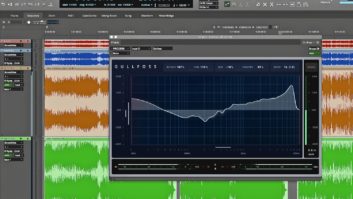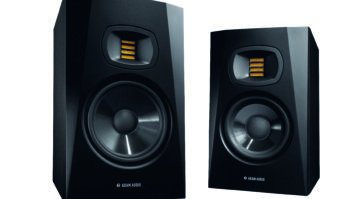Happy with my frequency balances, tones and dynamics, I’ve been disappointed with the width and imaging of my soundstage, even though I typically analog sum mixes for the soundstage depth. Once mastering squeezes out all but the last 9 or 10 dB of dynamics, I’m underwhelmed, wishing I had more separation, more clarity and less congestion. If only there were a way to easily fix that beyond better rooms, better hearing and better skills. Well, I think now there is.
Gullfoss is an intelligent equalizer that employs a sophisticated algorithm that has modeled what the human ear likes to hear, can apply those standards at varying user-selected degrees to incoming audio, utilizing EQ changes in tremendous number and frequency (up to 100 times per second) and increase the perception of clarity, space and dimension—and do all that without latency, artifacts or phase destruction. This probably sounds as impossible to you as it did me, as it should.
Related: Interview with Gullfoss Inventor Andreas Tell, by Rob Tavaglione, Pro Sound News, March 21, 2018
What makes all this possible is the depth and versatility of said algorithm; developed by Andreas Tell, an Icelandic fellow who dedicated 12 years of his life to the research behind Gullfoss (which is also the name of an iconic Icelandic waterfall and popular tourist draw). His work had much to do with quantum physics and mathematical theorems, more so than psychoacoustics or artificial intelligence.

The controls provided are not typical: Recover seeks to find elements within the mix, correct their equalization and phase relationships, and bring them more to the forefront. Tame seeks to find elements with too much prominence in your mix, correct their balances and subdue them. Bias allows you to choose your bias toward Recovering or Taming during moments of threshold in a fine-tuned way beyond the relative settings of Recover or Tame. Detail allows you to dial in more (or less) top-end and brightness, while Boost allows you to tailor the “loudness response curve” perceived as largely bottom-end response, with a boost or cut.
Whenever engaged, Gullfoss exhibits the amount of work it is doing with a frequency/amplitude display that rapidly bounces with the frequent boosting and cutting. Vertical meters show the Bias, the amount of Recovering or Taming, and the input and output level, as well as a pair of frequency filters (the red lines at the extreme left and right). These filters allow you to contain Gullfoss’ EQing to only the frequencies that lie between the frequency extremes you exclude, or you could reorder the two filters to create a bandpass-filter excluding a specific frequency range. The process will seem less complicated once you jump in and begin to tweak around.
Related: Soundtheory Ships Gullfoss Intelligent Automatic Equalizer, Pro Sound News, Feb. 20, 2018
Recover and Tame have a range from 0 to 200; upon taking each up to a mere 25 or so, the mix begins to clean up, revealing inner detail and clarity, as if the smoke got sucked out of the room. Take those controls up to 75-ish and the mix seems to jump to life with separation, transients, detail and attack. Take things up over 100 (which Soundtheory does not recommend) and finally things begin to get just a little too aggressive. A little too rude and crisp, the processing is then audible, but not loaded with artifacts like you might think. Still, like most things audio, moderation is the key to success.
Pull those controls back to reasonable levels, fiddle with Bias a little, maybe rebalance the top to bottom a touch, and the rewards are quite obvious in the sweet spot or headphones. Your mix gets bigger and wider, depth and detail are increased, murky low-mids are removed, transient detail is enhanced and the EQ balance seems more even and consistent. Out of the sweet spot, you cannot tell all of the above improvements, but EQ is definitely improved; in fact, I found that even if the playback system does not allow accurate imaging (car stereos, poorly placed speakers, mono systems) or is frequency-limited (i.e. Auratones), that translatability is nonetheless always enhanced by Gullfoss.

It was as if I had better drum overhead technique and mics, as if my guitars got out from under a blanket, as if my basses had that elusive perfect low-mid EQ sculpt, as if my vocals had a better mic and ideal EQ (and width, as my vocal stereo-izer processors and doubles basked in the glow). My reverbs—and especially my echoes—had an increased intelligibility and imaging I was convinced I could reach out and touch.
Convinced I had found the solution to my mix problems, I began to experiment. Solo mono sources could gain fidelity, if maybe not so much size. Voices, basses, single-miked instruments could all gain an ideal EQ curve, like using the world’s most responsive (and least destructive) multiband compressor or dynamic EQ. Stereo sounds, like synths or stereo-miked instruments, came to life with not only idealized EQ, but now with a bigger, wider and prettier soundstage. Stereo subgroups like drums gained significantly, too, with pinpoint internal imaging, better transients and smart, nimble EQ.
I tried Gullfoss on some live on-location gospel mixes I had recently completed, with interesting results. The usual improvements in frequency response, clarity and transient response were there, but I also noticed that a sense of the actual room came through better. I still remember how that choir sounded in that church, and I felt like I could sense that imaging and energy with more truthfulness. I am going to apply Gullfoss to my choir, drum and instrument subgroups (and mixes) in round two of this very project and preserve more of the concert’s vibe.
I’m afraid I cannot explain how this works—it defies logic—but I can say that the CPU hit on my black-donut Mac Pro was minimal and I didn’t even get a dropout when bypassing/engaging with my Digital Performer 9.51 DAW host. (Gullfoss buffers the audio even when in bypass.) Frankly, I’m rushing this review to press out of excitement, but I hope to find more operational limits over time and repeated experimentation.
Gullfoss is in an Early Access phase now, priced at $99, but with limited online authorizations only. Once Early Access ends, the price will be $199 for one offline activation and three online ones.
Exhibiting at the NAB Show? Enter the NewBay Best of Show Awards! EXTENDED DEADLINE: MARCH 30!
It appears we now have a growing crop of postmodern plug-in processors that can clearly exceed hardware limitations. I can sense resentment from some of you out there that AI (artificial intelligence) may ultimately spell the end for audio engineers. Gullfoss is not AI, however, just quite intelligent; it requires your experience to gauge severity, appropriateness and artistry. Fear not—it’s like my colleague said when testing, “Don’t worry, this isn’t your enemy replacement. This is the ultimate assistant.”
Soundtheory • soundtheory.com







